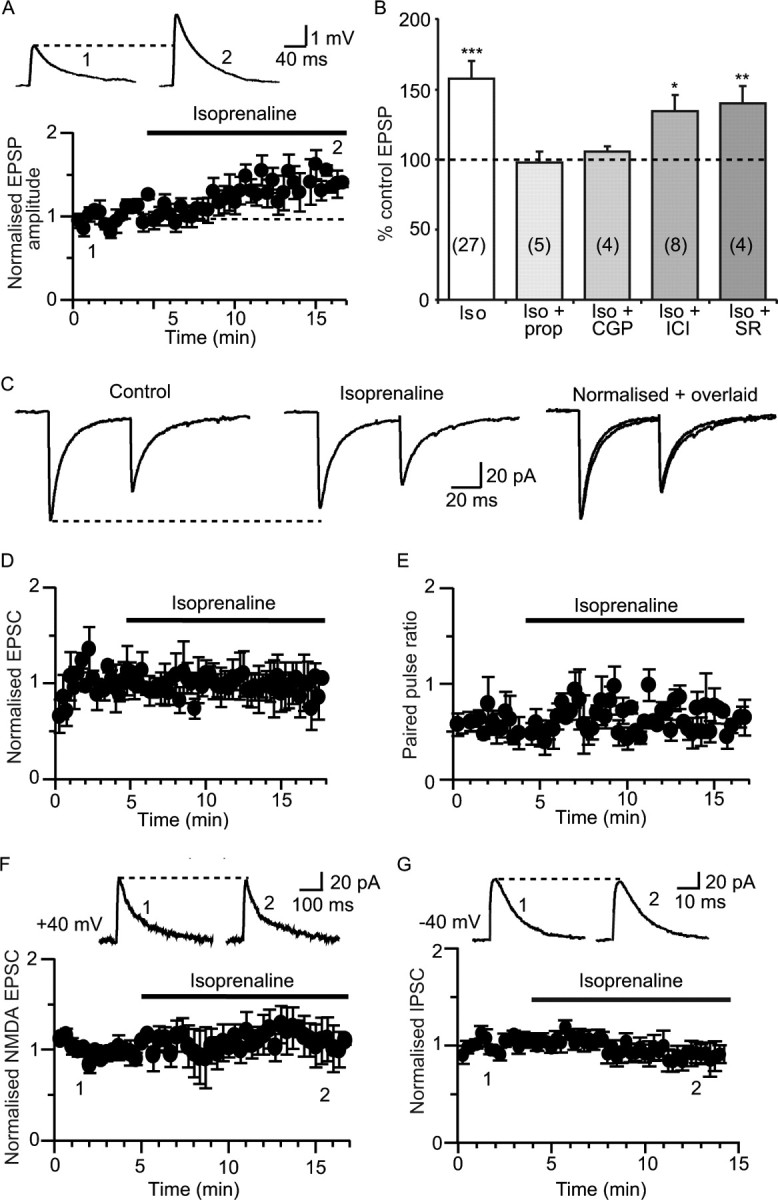Figure 1.

Beta adrenoceptor activation enhances excitatory synaptic transmission. A, Isoprenaline (10 μm) potentiates EPSPs evoked by stimulation of cortical afferents (from 2.9 ± 0.3 mV to 4.5 ± 0.4 mV; n = 23). Representative EPSPs recorded before and after isoprenaline are shown in insets at the time points illustrated on the graph in this and subsequent figures. B, Summary data showing the change in EPSP amplitude in isoprenaline (iso) and blockade of this effect by the nonspecific β adrenoceptor antagonist propranolol (prop; 10 μm) and by the selective β1 adrenoceptor antagonist CGP20712 (CGP; 100 nm) but not by the selective β2 or β3 antagonists, ICI118,551 (ICI; 10 nm) and SR59230A (SR; 100 nm), respectively. Numbers of cells in each measurement are shown in parentheses in the bars in this and subsequent figures. *p < 0.05; **p < 0.01; ***p < 0.001. C, Paired EPSCs recorded at −60 mV in voltage clamp. Isoprenaline has no effect on EPSCs evoked at a 60 ms interval (middle panel; mean amplitude 50.8 ± 13 pA; n = 7) compared with control conditions (left; mean amplitude 53.4 ± 12 pA; n = 7; p > 0.05) and does not change the paired-pulse ratio. Isoprenaline and control traces have been normalized and overlaid on the right panel. Time courses showing the lack of effect of isoprenaline on the EPSC (n = 7), and paired-pulse ratios (n = 7) are shown in D and E, respectively. F, Application of isoprenaline (10 μm) had no effect on NMDA-receptor-mediated EPSC amplitude recorded with a caesium-based internal solution (from 65 ± 17 pA in control to 72 ± 24 pA in isoprenaline; 108 ± 11%; n = 4; p > 0.05). G, Beta adrenergic activation has no effect on IPSCs (IPSCs, measured from a holding potential of −40 mV in the presence of 10 μm NBQX and 30 μm AP-5). Mean IPSC amplitude was 129 ± 26 pA in control and 120 ± 21 pA in isoprenaline (96 ± 9% of control; n = 7; p > 0.05).
